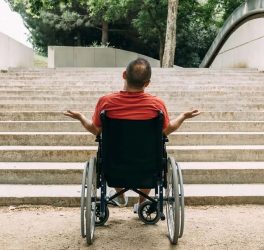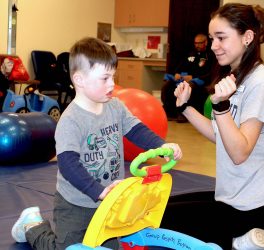
Jeremy King loved becoming a father, but the fact that he couldn’t push his baby in a stroller because he uses a wheelchair often made him sad.
That sadness quickly dissipated when a group of high school students in Maryland designed and built a wheelchair stroller attachment that enables people with disabilities to take their children on walks.
As reported by CNN, the idea came about when students at Bullis School, a private K-12 school in Potomac, discovered their teacher was expecting a baby, and her husband, who has a mobility disability, may never be able to walk his own child.
In 2017, Chelsie King, a 32-year-old middle-school theater teacher at Bullis, had been engaged to her now-husband Jeremy King, 37, for only three months when he was diagnosed with a brain tumor. Jeremy underwent an eight-hour surgery to remove it, but was left with a number of challenges, including an inability to balance.
Three years later, the couple discovered they were expecting a baby. Jeremy was so excited but also very worried about how he would be able to co-parent, or even take part in the joy of taking his baby for a walk.
“It was an immediate concern,” Jeremy said in a statement. “I was very concerned with the safety of myself and our child especially with Chelsie having to potentially support both of us. It played on my mind constantly which is why it was important for us to find things to help.”
Chelsie reached out to Matt Zigler, a fellow teacher who runs the BITlab – the school’s creative lab – and teaches a course called “Making for Social Good.”
Ten students immediately began working on the project, which they called the “WheeStroll.” They began brainstorming various ways to transform a wheelchair into a device that could accommodate a baby car seat and a stroller.
After interviewing their teacher and Jeremy, the students learned that their device would have to meet three design requirements: It had to be safe, easy to maneuver, and something Jeremy would be able to attach and detach without help from anyone else.
After weeks of experimenting, the students successfully created two designs: the WheeStroll Wheelchair Stroller Attachment, which uses a metal structure attachment to connect a car seat to a wheelchair, and the WheeStroll Wheelchair Stroller Adapter, which uses 3D-printed parts to attach an entire stroller to a wheelchair.
Phoenix King was born on March 4. Jeremy was ecstatic that he could walk little Phoenix from the safety and comfort of his wheelchair. “It was a very emotional experience because I never thought I would be able to do something safely like taking a walk with my child,” Jeremy said. “It has allowed me to experience things that I would not have been able to do before having the WheeStroll. It allows us as a family to have more freedom of movement.”
One of the most important parts of the project, Zigler said, was making sure it was simple and affordable enough to allow other families with disabilities to recreate it for their own use.
“We wanted to come up with a design that would be easily repeatable for other people with access to basic tools,” Zigler said.
The final design for the WheeStroll Wheelchair Stroller Attachment, which attaches a car seat to a wheelchair, requires simple tools — totaling up to less than $100 — and an easy design the class has shared online so anyone who needs it can access it.
The design comes with instructions, a material list, and even a video and photos showing the step-by-step process.
The WheeStroll Wheelchair Stroller Adapter, which is to be used with a stroller once the baby grows up, is a little bit more complicated since it requires a 3D printer, but is still easily created by anyone with access to one.
The team won two international awards by the Make:able 3D Printing Challenge for their wheelchair project, including “Best Inspirational Story” and “Best Showcase of Iterative Design.”








